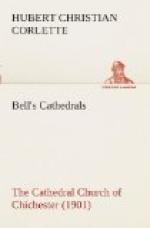But #Ralph Brideoake# (1675-1678) watched the political and ecclesiastical weathercocks, and feathered his nest. He had been “Chaplain to Speaker Lenthall, who gave him the rich living of Witney, near Oxford, where we are told he ’preached twice every Lord’s Day, and in the evening catechised the youth in his own house; outvying in labour and vigilancy any of the godly brethren in those parts.’ In 1659 he was made one of the ‘triers,’ yet immediately after the Restoration he was rapidly promoted to a canonry at Windsor, to the Deanery of Salisbury, and finally to the Bishopric of Chichester."[41] Though Bishop Henry King had endeavoured to restore the cathedral and the buildings of the precincts, these still were in a state of extreme dilapidation, for Bishop Brideoake’s record of his visitation shows that the towers, windows, and cloisters had not yet been repaired.
[41] Stephens’ “Diocesan History,” p. 233.
#Guy Carleton# (1678-1685) was a Royalist bishop of a most consistent type. On two occasions he had been turned out of a cure by the Parliamentary “triers” for his opinions; but in his eighty-second year he came from the see of Bristol to Chichester.
Another Royalist, who as a soldier had supported the cause of Charles I., occupied the see after Carleton. This was #John Lake# (1685-1689). He was one of those seven bishops who protested against James’s Declaration of Indulgence.
#Simon Patrick# (1689), #Robert Grove# (1691), #John Williams# (1696), #Thomas Manningham# (1709), #Thomas Bowers# (1722), and #Edward Waddington# (1724) served in the episcopate successively.
#Francis Hare# (1731-1740) then filled the vacancy. He wasted some of his time in useless controversy, and, as the Duke of Marlborough’s chaplain, made his office cheap, though perhaps popular, by occasionally dilating in his sermons upon the genius and military skill of his patron. He was a man of some capacity, who advised conformity to the meagre and starved ideals of the then accepted orthodoxy. Apparently he deemed this course a safe one, where there could, it appears, be little other guidance for those who still had any faith, except in the conventionalities of what had become ecclesiastical custom. He saw that the interpretation which individual opinion in its practical rejection of Christian ordinances would read into faith was likely to be no more than a new expression of early and mediaeval heresies.
#Mathias Mawson# (1740-1754) was bishop after Hare; and then Sir #William Ashburnham# (1754-1799) came to the diocese and occupied the see for forty-five years, “the longest episcopate since the foundation of the see.” [42]
[42] Stephens, p, 245.
Before the close of the eighteenth century #John Buckner# (1799-1824) succeeded Ashburnham.
In 1824 #Robert James Carr#, and in 1831 #Edward Maltby#, were appointed to the see.
[Illustration: S. CLEMENT’S CHAPEL, AND TOMB OF BISHOP DURNFORD (SEE p. 83). S.B. Bolas & Co., photo.]




